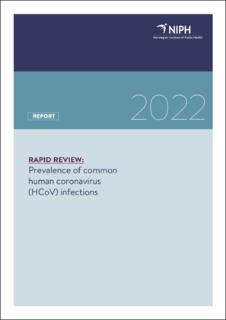| dc.contributor.author | Flodgren, Gerd Monika | |
| dc.contributor.author | Steiro, Asbjørn | |
| dc.contributor.author | Brurberg, Kjetil Gundro | |
| dc.contributor.author | Rose, Christopher James | |
| dc.date.accessioned | 2022-07-15T06:20:29Z | |
| dc.date.available | 2022-07-15T06:20:29Z | |
| dc.date.created | 2022-06-28T14:08:14Z | |
| dc.date.issued | 2022 | |
| dc.identifier.isbn | 978-82-8406-311-9 | |
| dc.identifier.uri | https://hdl.handle.net/11250/3005636 | |
| dc.description.abstract | Hovedbudskap
Område for helsetjenester ved Folkehelseinstituttet (FHI) har gjennomført denne hurtigoversikten om forekomst av vanlige humane koronavirus (HCoV-OC43, HCoV-NL63, HCoV-229E og HCoV-HKU1). Hurtigoversikten var bestilt fra Område for smittevern, FHI.
Vi inkluderte 83 primærstudier som rapporterte prevalens av vanlige humane coronavirus (HCoV). Prevalens ble sett i sammenheng med bl.a. alder, geografisk region og landsøkonomi. Femten studier rapporterte om samtidig infeksjon med ulike HCoV stammer.
Resultatene viser:
• Gjennomsnittlig prevalens av HCoV på tvers av ti geografiske regioner i hele verden var 4 %
• Prevalens av HCoV var kanskje noe lavere i de sørøstlige og østasiatiske geografiske regioner (2-3 %) enn i Afrika (6-14 %)
• Prevalens av HCoV blant spedbarn og barn (5 %) er muligens noe høyere enn hos voksne og eldre (3 %)
• Vi fant ingen konsistent sammenheng mellom prevalens av HCoV og lands inntektsnivå
• HCoV sees noe oftere i sammenheng med infeksjoner i øvre (6 %) enn i nedre luftveier (3 %)
• I perioden mellom 2005 og 2018 var det liten variasjon i prevalens av HCoV over tid
• Samtidig infeksjon med flere HCoV-stammer varierte fra median 0,3 % (0,2 % til 13,8 %) for OC43+HKU1 til 2,1 % (0.5 % til 10,0 %) for OC43+229E
• Samtidig infeksjon med andre luftveisvirus var vanlig (~47 % av alle HCoV-tilfeller)
• Få studier rapporterte data fra lavinntektsland. Informasjon om type lufteveisinfeksjon, innleggelser og studiested var i mange tilfeller uklart eller mangelfullt rapportert
• Ingen av de inkluderte studiene rapporterte om sosiale forhold (f.eks. minoritetsstatus og SES)
Fremtidige studier bør samle data om sosiale forhold, bruke standardiserte prosedyrer for PCR-analyse og forbedre rapporteringen generelt. | |
| dc.description.abstract | Key message
Division for Health Services at the Norwegian Institute of Public Health (NIPH) conducted a rapid review of prevalence of common human coronaviruses (HCoV-OC43, HCoV-NL63, HCoV-229E, and HCoV- HKU1). This rapid review was commissioned by the Division for Infection Control, NIPH.
We included 83 original studies that reported prevalence of common HCoVs. Prevalence was analysed in association with age, geographic regions and country income levels. Fifteen studies also reported on co-infections between different HCoV strains. The results show:
• Mean prevalence og HCoV across ten geographic regions throughout the world was 4%
• Prevalence of HCoVs was possibly lower in the South-East and East Asian geographical regions (2-3%) compared to African regions (6-14%)
• Prevalence of HCoVs among infants and children (5%) was possibly lower than among adults and older adults (3%)
• We could not detect a consistant relationship between HCoV prevalence and country income level
• HCoVs are more frequently observed in association with upper respiratory tract infections (RTI) (6%) than in lower RTIs (3%)
• In the period between 2005 and 2018, there was little variations in the prevalence of HCoV over time
• Co-infections between HCoV strains ranged from median 3% (0.2 to 13.8) for OC43+HKU1 to median 2.1% (0.5 to 10.0) for OC43+229E
• Co-infections with other respiratory virus were common (around 47% of HCoV positive cases).
• Few studies reported data for low-income countries, and data on RTI type, admission status, and study location were in many studies unclear or lacking.
• None of the included studies reported on social determinants of health (e.g. minority status and SES), and therefore equity issues related to HCoV prevalence could not be addressed in this review.
Future studies should aim to collect data on social determinants of health, use standardized sample types for PCR analysis, and improve reporting in general. | |
| dc.language.iso | eng | |
| dc.publisher | Norwegian Institute of Public Health / Folkehelseinstituttet | |
| dc.relation.uri | https://www.fhi.no/globalassets/dokumenterfiler/rapporter/2022/prevalence-of-common-human-coronavirus-hcov-infections-report-2022.pdf | |
| dc.subject.mesh | Common coronavirus | |
| dc.subject.mesh | Seasonal coronavirus | |
| dc.subject.mesh | Human coronavirus | |
| dc.subject.mesh | HCoV229E | |
| dc.subject.mesh | HCoV-HKU1 | |
| dc.subject.mesh | HCoV-NL63 | |
| dc.subject.mesh | HCoV-OC43 | |
| dc.subject.mesh | HumanCoV-229E | |
| dc.subject.mesh | HumanCoV-HKU1 | |
| dc.subject.mesh | HumanCoV-NL63 | |
| dc.subject.mesh | HumanCoV-OC43 | |
| dc.subject.mesh | sCoV-229E | |
| dc.subject.mesh | sCoVHKU1 | |
| dc.subject.mesh | sCoV-NL63 | |
| dc.subject.mesh | sCoV-OC43 | |
| dc.title | Prevalence of common human coronavirus (HCoV) infections: a rapid review | |
| dc.title.alternative | Forekomst av vanlige humane koronavirusinfeksjoner: en hurtigoversikt | |
| dc.type | Research report | |
| dc.description.version | publishedVersion | |
| dc.source.pagenumber | 99 | |
| dc.identifier.cristin | 2035819 | |
| cristin.ispublished | true | |
| cristin.fulltext | original | |
